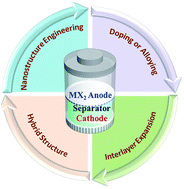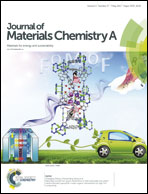Recent progress in layered metal dichalcogenide nanostructures as electrodes for high-performance sodium-ion batteries
Abstract
Sodium-ion batteries (SIBs) have emerged as a promising candidate for large-scale stationary energy storage in light of possible concerns over cost and abundance. Advanced sodium host materials are required for developing SIBs with high energy density, long cycling stability and high safety. Layered metal dichalcogenides (MX2, M = Mo, W, Sn, V, Ti; X = S, Se, Te) have become a hot spot for anode materials in SIBs due to their merits of high conductivity, mechanical and thermal stability and structural stability. In this review, we first present a comprehensive overview of the progress of layered MX2 anodes for SIBs. Detailed discussion on the advantages of MX2 as SIB anodes is then made. Emphasis is placed on enhancing the electrochemical performance through nanostructure engineering, crystal structure modulation, doping/alloying and composite design. We conclude with a perspective on the further development of SIBs in view of their applications.

- This article is part of the themed collection: Recent Review Articles


 Please wait while we load your content...
Please wait while we load your content...